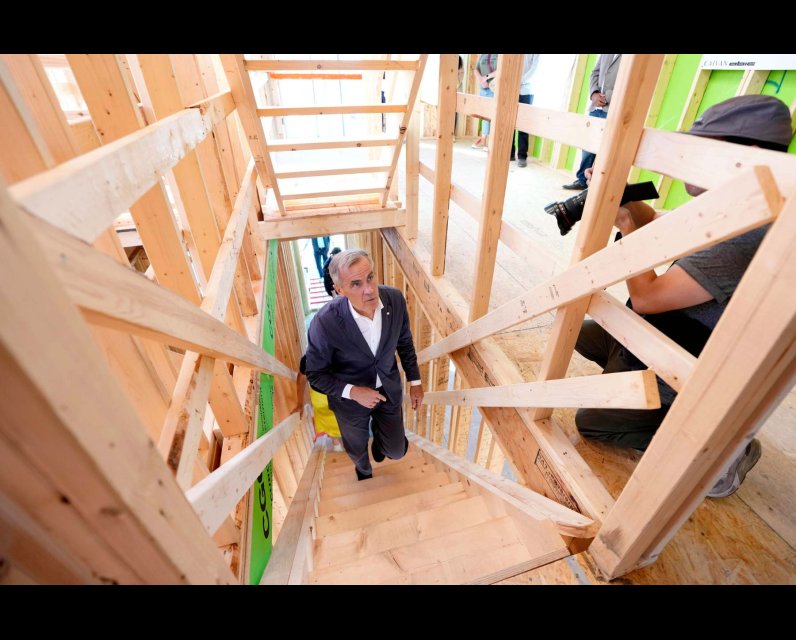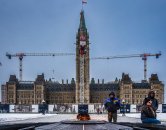Only Half the Country Thinks Carney’s “Nation-Building Projects” Are a Good Idea

In September, Prime Minister Mark Carney’s Liberal government unveiled an initial list of “major projects” to be reviewed and, possibly, fast-tracked. This flagship commitment from last spring’s federal campaign was designed both to stimulate the Canadian economy and to respond to tariffs imposed by US president Donald Trump on Canadian exports.
A new poll from the Angus Reid Institute gauged how Canadians saw this list. Obviously, few voters will have had the chance to study these proposals so early in the process, so the exercise serves as a first impression of Carney’s election promise—a benchmark in public opinion that will serve as a reference point as these plans move forward.
The Angus Reid questionnaire presented respondents with the five projects:
- Phase 2 of the LNG Canada terminal in Kitimat, British Columbia
- The Darlington–Bowmanville nuclear power plant in Ontario
- The Contrecoeur container terminal project in Quebec
- The Foran copper mining project in McIlvenna Bay, Saskatchewan
- The expansion of the Red Chris copper mine in British Columbia
At the national level, 44 percent of respondents said they were satisfied with the initial list, compared to 32 percent who were not. Nearly a quarter—24 percent—were undecided. While the numbers don’t suggest any great euphoria, they do indicate a respectable starting point for the federal government, which is betting heavily on the success of these projects.
!function(){"use strict";window.addEventListener("message",function(a){if(void 0!==a.data["datawrapper-height"]){var e=document.querySelectorAll("iframe");for(var t in a.data["datawrapper-height"])for(var r,i=0;r=e[i];i++)if(r.contentWindow===a.source){var d=a.data["datawrapper-height"][t]+"px";r.style.height=d}}})}();
Notably, the highest satisfaction rates are in the provinces crucial to the Liberal victory last spring: the Atlantic provinces (54 percent), British Columbia (46 percent), and Quebec (45 percent). Support is more lukewarm in Manitoba (38 percent) and Alberta (39 percent). But the gap between the proportions of satisfied and dissatisfied remains statistically small—leaving Carney buoyed, for now, by cautious optimism nationwide.
This mood underscores the larger task ahead. Because what Carney is really testing isn’t just our belief in infrastructure but the belief that, in a fractured nation, collective ambition still matters.
Broken down by political affiliation, the results reveal far less polarization than usual. Four in ten Bloc Québécois (39 percent) and New Democratic Party (38 percent) voters welcome the government’s initial choices. Carney can even count on the support of a segment of the Conservative electorate, where nearly three in ten voters (28 percent) say they are satisfied.
!function(){"use strict";window.addEventListener("message",function(a){if(void 0!==a.data["datawrapper-height"]){var e=document.querySelectorAll("iframe");for(var t in a.data["datawrapper-height"])for(var r,i=0;r=e[i];i++)if(r.contentWindow===a.source){var d=a.data["datawrapper-height"][t]+"px";r.style.height=d}}})}();
On the Liberal side, a majority of respondents are satisfied, but they are not unanimous either: 66 percent of Liberal voters approve of the government’s initial list. We are therefore not in the 90-10 ratios that we so often encounter along partisan lines.
It did not go unnoticed that this first tranche of major projects does not include any investment in Alberta’s oil sector. However, recent discussions between Carney and Alberta premier Danielle Smith seem to have appeased provincial Conservatives’ discontent with the federal government. Shortly after a meeting between Smith and Carney earlier this month, the premier wrote on social media: “I am more optimistic than ever that the concerns of Albertans are FINALLY BEING HEARD.”
These new figures from Angus Reid will undoubtedly reinforce Smith’s optimism, as a majority of Canadians, 57 percent, want the Carney government to fast-track the development of gas and oil projects, compared to 31 percent who oppose it.
Unsurprisingly, support is highest in oil-producing provinces—namely, Alberta (71 percent) and Saskatchewan (70 percent).
And in Quebec, where it is often said that there is little social acceptance for fossil fuel projects? The figures suggest that opinions are much more nuanced. Among the Quebec sample in the survey, 44 percent agree with the statement that Carney should add oil and gas investments to future lists of major national projects, compared to 38 percent who oppose it.
!function(){"use strict";window.addEventListener("message",function(a){if(void 0!==a.data["datawrapper-height"]){var e=document.querySelectorAll("iframe");for(var t in a.data["datawrapper-height"])for(var r,i=0;r=e[i];i++)if(r.contentWindow===a.source){var d=a.data["datawrapper-height"][t]+"px";r.style.height=d}}})}();
Several recent polls suggest Quebec voters are more open to fossil fuel development than the province’s politicians have been in recent years. A survey by Nanos Research published this summer found that 65 percent of Quebecers agreed with the statement “Canada should expand oil and gas exports to help the world have more secure and reliable energy supplies.”
Nevertheless, if Carney pushes ahead with major fossil fuel projects, his aura as a banker with an environmental conscience could take a serious hit. The Angus Reid poll found that one-third of Canadians believe the Carney government has abandoned Canada’s greenhouse gas reduction commitments. This proportion rises to 45 percent in Quebec, the highest in the country.
!function(){"use strict";window.addEventListener("message",function(a){if(void 0!==a.data["datawrapper-height"]){var e=document.querySelectorAll("iframe");for(var t in a.data["datawrapper-height"])for(var r,i=0;r=e[i];i++)if(r.contentWindow===a.source){var d=a.data["datawrapper-height"][t]+"px";r.style.height=d}}})}();
The federal government’s press release admits what many in the business community have been saying for years: “Investors, provinces and territories, and the business community have expressed that it is too difficult and takes too long to build economically feasible projects in Canada.” The list is meant as a show of intent from a government eager to prove it can get big things done.
For now, Carney has a workable level of early support. But turning these plans into reality will take time, billions of dollars, and delicate negotiations with provinces and First Nations. Where there’s ambition, there’s also risk—economic and political alike.
The full Angus Reid survey report is available here.
The post Only Half the Country Thinks Carney’s “Nation-Building Projects” Are a Good Idea first appeared on The Walrus.


Comments
Be the first to comment